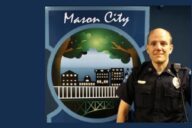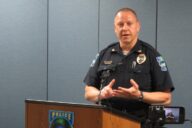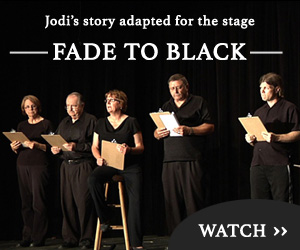The September/October 2017 issue of PI Magazine includes an interview with FindJodi.com’s Caroline Lowe, focusing on the 22-year search for Jodi Huisentruit.
Our FindJodi.com team is grateful for this latest spotlight on Jodi’s case, and for PI Magazine’s permission to republish the article on our website.
Media coverage like this piece helps keep Jodi in the public eye. We hope someone reading or watching a news report will come forward with the information critically needed to provide answers to what happened to Jodi.
PI Magazine is a national trade publication for professional investigators. www.PImagazine.com
Here is the excerpt from the article:
The 22-Year Search for Jodi Huisentruit
PI: Caroline, tell us about Jodi Huisentruit.
Cl: Jodi was the 27-year-old anchor for the morning news at the CBS affiliate in Mason City, Iowa, in the 153rd television market in the country, which is “the beginner level” for a young TV journalist.
PI: What happened on Tuesday, June 27, 1995?
CL: Jodi’s schedule required her to be at the studio of KIMT-TV at 3 a.m., but it was only a mile from her apartment. When she hadn’t made it to the TV studio by 4 a.m., her assistant producer, Amy Kuns, telephoned to make sure she was still coming to work to anchor the 6 a.m., hour-long newscast. Evidently Jodi had simply overslept. She told Amy she’d soon be at the station. The day before had been a very long work day for Jodi. After anchoring the Monday morning newscast, Jodi spent the day participating at an annual Mason City Chamber of Commerce golf fund raising event which she left at 8 p.m. Even though this was a “work” related event, Jodi was a passionate golfer who was happy to be a part of it.
After their brief chat, Amy Kuns put the newscast together, expecting to see Jodi by 4:30 a.m. At 6 a.m., when Jodi didn’t appear, Amy sat at the anchor desk and delivered the news. After the newscast ended at 7 a.m., Amy asked a colleague to call police for a welfare check.
PI: What did the Mason City police find?
CL: There were clear signs a crime had occurred. In the parking lot of the apartment complex, police found Jodi’s new red Mazda Miata, with a bent key nearby. A pair of red high heel shoes, earrings, and a blow dryer were on the ground. Drag marks on the surface of the parking lot indicated there had been a struggle. A partial palm print was recovered from her car. Neighbors recalled hearing a scream between 4 and 5 a.m. and someone had seen a white van in the parking lot.
PI: So Amy Kuns was the last person known to have spoken to Jodi. Who was the last person to see her before her abduction?
CL: An older friend of Jodi’s, John Vansice, said he was. Vansice showed up at the parking lot that morning while police officers were on the scene. He told them Jodi stopped by his home the night before to watch a video of the surprise birthday party he gave on her 27th birthday, a few weeks earlier. Vancise was a salesman who was about 20 years older than Jodi. Recently he had taken Jodi waterskiing with friends and he named his boat after her. As the investigation proceeded, John Vansice was interviewed and polygraphed. He denied having anything to do with Jodi’s abduction and repeatedly refused media requests for interviews.
PI: How much attention was given to the case of Jodi Huisentruit?
CL: State and federal investigators quickly joined the search for Jodi. National news crews also flocked to Mason City, a small Iowa town near the Minnesota state line. Hundreds of volunteers took part in searches in the area, putting up flyers and wearing ribbons. Billboards carried photos of the blonde anchorwoman who was 5’3” tall and weighed 120 pounds. While the community and law enforcement searched for Jodi, investigators explored several possible scenarios about her disappearance. The big questions were whether Jodi was abducted by someone she knew or had she been targeted by a stalker who watched her on television? Or could it have been a random case where someone just happened to see this young woman alone in the parking lot in the dark?
PI: Caroline, how did you get involved with this 22-year-old case?
CL: I got involved in 1997, about two years after Jodi was abducted. Back then, I was a reporter covering the crime and investigative beats for WCCO-TV in Minneapolis, which is the 14th largest television market in the country. I have always had an interest in missing persons and unsolved crimes. In this case, not only was Jodi a fellow TV journalist, but she was working two hours south of Minneapolis and her home town of Long Prairie, Minnesota, population 3,450, was two hours north-west of us. She had studied broadcast journalism at nearby St. Cloud State University. After a couple years at the station in Mason City, hoping to move to a major market, Jodi had applied to work at Twin Cities stations. Sadly, instead of someday getting a chance to work at one of those stations, clips from her audition tape were used to illustrate the ongoing story of her disappearance.
PI: Describe what you – or the station – did to provide WCCO-TV’s coverage of this story.
CL: Although Mason City was not in our viewing area, WCCO-TV and the other Twin Cities stations devoted a lot of time and resources on Jodi’s case. Part of it was her Minnesota roots, but it was also because this was a young woman that so many of us could relate to as she pursued her professional dream to someday work with us. We covered countless police news conferences, chased “promising” leads, interviewed Jodi’s family, friends and KIMT-TV coworkers, collected photos, sifted through police reports, did milestone updates and stayed in touch with authorities.
PI: Did you follow up with Jodi’s friend John Vancise?
CL: I tried to, with no luck. I thought he might be willing to talk with me after I did a series of WCCO I-Team reports on a Twin Cities serial rapist named Tony Dejuan Jackson who lived in Mason City at the time Jodi disappeared. Vansice moved near Phoenix, Arizona. That’s where I tracked him down in 1998 and cornered him outside a restaurant, trying to get his side of the story. He refused to talk to me.
PI: How did this Tony Dejuan Jackson become a possible suspect?
CL: About two years after Jodi’s abduction, Jackson was in a Twin Cities jail, after being arrested and charged with several “stranger rapes” in the area, but he had once lived in Mason City. Minnesota law enforcement sources told the Mason City police about him and suggested we check out his background in Mason City. Our investigation found Jackson lived just two blocks from KIMT-TV when Jodi vanished. His girlfriend, who looked a lot like Jodi, broke up with Jackson the week before Jodi was abducted. After our first reports on Jackson suggested he needed a close look, a cell mate claimed that Jackson wrote a rap rhyme about what happened to Jodi.
WCCO-TV even brought in cadaver dogs who, accompanied by law enforcement, searched a rural site in Tiffin, Iowa. The dogs alerted on a couple items which were sent to the Iowa crime lab for tests. The results did not produce any connection to Jodi. I was able to conduct telephone interviews with Jackson while he was in jail. He repeatedly denied having anything to do with Jodi’s disappearance – but he also denied the rapes, despite DNA, fingerprints and other evidence that led to his convictions. After our reporting on WCCO-TV, police in Mason City, further investigated Tony Dejuan Jackson and eventually ruled him out as a possible suspect.
PI: How did you create your rapport with law enforcement?
CL: Some of it comes from covering a crime beat, but I also went back to college to finish my degree, majoring in law enforcement at Metropolitan State University. Then I earned a master’s in police leadership from the University of St. Thomas. I took the police academy training in Minnesota and worked a temporary assignment as a uniformed officer for eight years during the Minnesota State Fair.
PI: Caroline, as the years went by, how did your TV career change?
CL: I continued to cover crime and investigative beats for WCCO-TV until April 2011. Six years ago, after 34 years at WCCO-TV, I decided to begin a new professional chapter in California, in part to be closer to three of our kids who live there and to live in a warmer climate. I joined the San Luis Obispo NBC affiliate, KSBY-TV, as the manager of their Santa Barbara County newsroom. I loved the opportunity to mentor a young group of reporters in a small market. In June 2015, after four years in that assignment, I decided I’d missed being on the street. My first assignment as a reporter was investigating how missing persons cases were handled on the Central Coast.
The week our report aired on KSBY-TV, the KARE-11 news director in Minneapolis, Jane Helmke, reached out to me to see if I could work on a special assignment for KARE. There was finally a break in the case of Jacob Wetterling, which I had also covered for more than 20 years. Jacob was an 11-year-old St. Joseph, Minnesota, boy abducted by a masked gunman in October 1989 as he and his brother and best friend were biking home from a trip to rent a video at a nearby convenience store. Coincidentally, in our careers both Jodi Huisentruit and I had conducted interviews with Jacob’s mother, Patty Wetterling.
Read the article here (PDF)
I spent the next year travelling back and forth to Minnesota, reporting on 52-year-old Danny Heinrich, a man arrested on federal porn charges whom officials called a person of interest in Jacob’s case. As part of a plea deal on the porn charges, Heinrich led investigators to a farm where they found Jacob’s remains and clothes in late August 2016. I was in the front row in a federal courtroom in Minneapolis a few days later when Heinrich shared the horrific details of the kidnapping and murder of Jacob. It was an emotional experience, especially hearing Heinrich quote Jacob’s last words, including “What did I do wrong? “ and “I want to go home.” After Jacob’s case was finally solved after 27 years, I felt a new sense of hope and resolve to help bring Jodi home. Jodi was declared legally dead in 2001, but her family stayed involved in the investigation. Sadly, her mom died a couple of years ago, still waiting for answers and a chance to say goodbye
PI: Why did you get a private investigator license?
CL: I received my Minnesota license in December 2015. My application mentioned that I wanted PI tools and training to help investigate cases like Jodi Huisentruit and Jacob Wetterling, whose photos have always been on my desk. My first application for a PI license in California was denied in 2015 because the state had stopped considering investigative journalism as qualifying credentials for a license. My California mentor Francie Koehler led the way to get the law changed. In June 2017, I became the first investigative journalist licensed under AB2632.
PI: What are the organized efforts to keep the case of Jodi Huisentruit active?
CL: On the 22nd anniversary of her disappearance, the Mason City Police Department issued a press release and renewed the pledge for a reward for information. Midwestern media picked up on the anniversary. There were also many posts on social media because of the website FindJodi.com, to which I belong. It was started in 2003 by Josh Benson, a former Minnesota
TV reporter who is now an anchorman at WFLA-TV in Tampa, Florida, and by Gary Peterson, an Austin, Minnesota, TV news director who had been Josh Benson’s boss. They produced a series of award winning investigative reports called “The Huisentruit Files.” The Find Jodi team includes Beth Bednar, a former Minnesota TV anchor who wrote a book, “Dead Air, The Disappearance of Jodi Huisentruit”, Jay Alberio, a retired police commander from suburban Woodbury, Minnesota, who investigated Jackson’s rapes, and Tara Manis Benson, who was a Florida TV news producer.
PI: What is the goal of FindJodi.com?
CL: The purpose of our team is to keep Jodi’s investigation from fading from the spotlight and to investigate any lead that comes our way. I have spent more than 20 years covering Jodi’s disappearance, hoping that spotlighting her case might finally lead to a break. Now that I have my private investigator’s licenses in Minnesota and California, I continue to search for answers. I told my husband I am not becoming a PI to earn an income, I am doing it to try to resolve some cold cases like Jodi Huisentruit that should not be forgotten.
This article was first printed in PImagazine.com.








